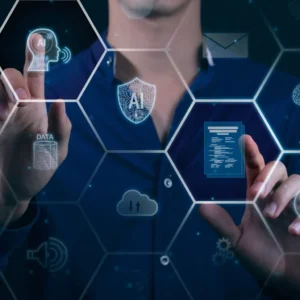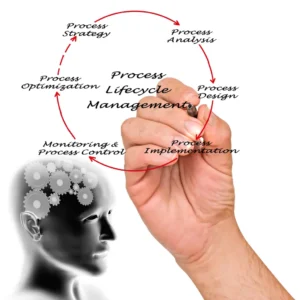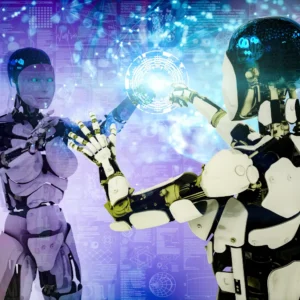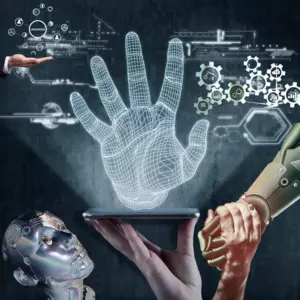
Empowering Success
Training and Upskilling for an AI-Enabled Workforce in the Era of IPA
In the transformative era of Intelligent Process Automation (IPA), the strategic imperative of “Training and Upskilling for AI-enabled workforce for IPA” takes centre stage.
Preparing a skilled and adaptable workforce becomes paramount as businesses navigate the intricate landscape of AI adoption. This article delves into the essential components of training initiatives tailored for IPA, addressing the evolving needs of both business and technical solution providers.
From addressing skill gaps and fostering cross-functional collaboration to customizing training programs and nurturing a culture of continuous learning, the phrase encapsulates a comprehensive strategy.
Moreover, incorporating external partnerships, alongside measuring and recognizing progress, amplifies the efficacy of training frameworks.
This exploration aims to guide organizations in adopting AI and cultivating a workforce that thrives in leveraging its potential for sustained innovation and success.
Table of Contents

Arindam Roy
An Automation Consultant with 25+ years of IT Experience
Rapid Technological Advancements
In the fast-evolving realm of AI, staying current is paramount. Rapid technological advancements drive continuous innovation, necessitating a workforce with updated skills. Regular training is the linchpin, ensuring employees remain abreast of the latest AI technologies.
As the AI landscape transforms, businesses must invest in their workforce’s knowledge base. Training initiatives become the conduit through which employees gain proficiency in leveraging cutting-edge AI solutions. This proactive approach not only fosters adaptability but also bolsters organizational efficiency.
The phrase “Training and Upskilling for AI-Enabled Workforce for IPA” resonates in this dynamic environment. It encapsulates the essence of preparing employees for Intelligent Process Automation (IPA) by embracing ongoing education. Through tailored programs, businesses cultivate a workforce capable of navigating the intricacies of evolving AI technologies.
By prioritizing training, organizations lay the foundation for a future-ready workforce. Employees with the latest AI skills contribute to increased productivity, streamlined processes, and a resilient business framework. In essence, the commitment to continuous learning is the catalyst that propels both business and technical solution providers toward sustained success in the AI era.
Enhanced Productivity and Efficiency
Investing in “Training and Upskilling for AI-Enabled Workforce for IPA” is more than a strategic move; it’s a key driver of enhanced productivity and efficiency in the workplace.
Equipping employees with AI skills is akin to providing them with powerful tools. Through proper training, individuals can automate mundane and repetitive tasks. This frees up valuable time and minimizes the risk of errors associated with manual processes.
Moreover, AI-trained staff brings a heightened capacity for data analysis. They can navigate vast datasets efficiently, extracting valuable insights that might be elusive without these skills. This analytical prowess empowers decision-makers to make well-informed choices, steering the organization toward success.
In the AI landscape, where precision and speed are paramount, the phrase “Training and Upskilling for AI-Enabled Workforce for IPA” underscores the need for a workforce proficient in intelligent process automation. Such proficiency translates directly into improved operational efficiency.
The symbiosis of proper training and AI skills unlocks a realm of possibilities. The workplace becomes a hub of streamlined processes, automated workflows, and data-driven decision-making, creating unparalleled productivity and efficiency. Embracing this synergy is not just a choice; it’s a strategic imperative in pursuing organizational excellence.
Job Security and Career Growth
“Training and Upskilling for AI-Enabled Workforce for IPA” emerges as a strategic investment, a safeguard for job security, and a catalyst for career growth. In AI, where adaptability is paramount, employees embracing training initiatives secure their relevance. Acquiring AI skills transforms them into valuable assets capable of navigating the intricacies of evolving technologies.
This proficiency shields against obsolescence, enhancing job security in an era where staying current is non-negotiable. Organizations, recognizing the value of skilled personnel, are inclined to retain and nurture such talent.
Simultaneously, the phrase emphasizes the pivotal role of AI skills in opening avenues for career growth. Employees with these competencies become natural contenders for leadership roles and strategic positions within the company.
The symbiotic relationship between “Training and Upskilling for AI-Enabled Workforce for IPA” and career progression is evident. The commitment to acquiring AI skills ensures job security by staying relevant and becomes a stepping stone for climbing the career ladder within the organization. In essence, embracing AI training becomes a strategic pathway for professionals aiming to secure their roles today and advance their careers tomorrow.
Adaptability to Change
“Training and Upskilling for AI-Enabled Workforce for IPA” is pivotal in fostering adaptability within organizations amid AI adoption. As AI becomes integral, organizational changes are inevitable. Training programs become the linchpin, empowering employees to adapt to new workflows, tools, and methodologies seamlessly.
These programs serve as a dynamic conduit for cultivating a culture of continuous learning. In the face of evolving technologies, adaptability becomes a core competency. The phrase underscores the imperative nature of preparing the workforce for the changes AI brings.
By embracing training initiatives, businesses ensure their employees stay relevant and instil a mindset of flexibility. This adaptability is a cornerstone in navigating the shifting landscapes of technology and business strategies.
“Training and Upskilling for AI-Enabled Workforce for IPA” encapsulates a strategic approach – an investment in skills and organizational resilience. As employees become adept at embracing change, organizations position themselves to weather transformations and thrive amid them. In the dynamic world of AI, adaptability is not just an asset; it’s a competitive advantage that ensures sustained success.
Cross-Functional Collaboration
In the realm of AI, collaboration becomes paramount, transcending departmental boundaries. “Training and Upskilling for AI-Enabled Workforce for IPA” becomes the catalyst for breaking down silos. AI’s integration into diverse business facets necessitates a collaborative mindset. Training programs bridge departmental gaps, encouraging a holistic understanding of AI’s applications. Employees equipped with cross-functional knowledge become invaluable assets.
This phrase underlines the strategic imperative of preparing a workforce that sees beyond individual roles. Collaborative proficiency enhances problem-solving, innovation, and efficiency in the face of multifaceted challenges posed by AI.
Organizations emphasize training initiatives and nurture a collaborative ethos by equipping employees with technical skills. The seamless integration of AI across various departments becomes a driving force for the business.
Essentially, “Training and Upskilling for AI-Enabled Workforce for IPA” is a transformative investment. It is a commitment to cultivating a workforce that understands the technical intricacies of AI and collaborates seamlessly across functions, creating a harmonious and effective environment for AI-driven success.
Addressing Skill Gaps
In AI adoption, recognizing skill gaps is paramount. “Training and Upskilling for AI-Enabled Workforce for IPA” becomes the strategic solution. Identifying gaps allows organizations to tailor training initiatives precisely. This targeted approach ensures employees acquire the necessary competencies for proficient AI integration.
The phrase underscores the practicality of addressing specific gaps in AI skills. Training becomes a tailored investment, aligning the workforce with the demands of evolving technologies.
Through this strategic alignment, businesses mitigate skill shortages and fortify their AI initiatives. The phrase encapsulates the proactive stance of ensuring every employee possesses the requisite skills for effective AI utilization.
“Training and Upskilling for AI-Enabled Workforce for IPA” signifies a systematic approach. It’s about recognizing the unique skill needs, tailoring training accordingly, and fortifying the workforce to meet the challenges posed by AI. This proactive strategy ensures a workforce with generic knowledge and the precise skills required for optimal AI performance.
Customized Training Programs
“Training and Upskilling for AI-Enabled Workforce for IPA” advocates precision in addressing organizational needs through customized training programs. Organizations must align training with specific AI adoption goals. Tailoring programs ensure relevance, offering technical training for developers, enhancing data literacy for non-technical staff, and providing executive leadership training.
This approach encapsulates the phrase’s essence, emphasizing the importance of a strategic and targeted training framework. Tailoring initiatives to job roles enhances efficiency, ensuring that each employee acquires the precise skills needed to contribute to AI adoption.
In the dynamic landscape of AI, a one-size-fits-all training approach needs to be revised. The phrase underscores the need for customization. It signals a departure from generic training, directing organizations to strategically invest in building expertise tailored to the intricacies of their operations.
By embracing customized training, businesses align their workforce with the specific demands of AI technologies. This tailored investment enhances employee proficiency and optimizes the overall impact of AI adoption, fostering a workforce that is adept, informed, and aligned with organizational objectives.
Continuous Learning Culture
“Training and Upskilling for AI-Enabled Workforce for IPA” champions a culture of perpetual learning in the face of AI’s rapid evolution. Building this culture is imperative. Encouraging employees to seek new skills and explore emerging technologies actively is a strategic imperative.
The phrase encapsulates the essence of perpetual education, emphasizing that training is not a one-time event but an ongoing process. This commitment to continuous learning ensures that the workforce remains agile and adaptable in the ever-changing world of AI.
Organizations should invest in structured employee training and create a culture that values self-improvement. This encouragement for employees to participate in ongoing training programs aligns with the phrase’s ethos.
In essence, “Training and Upskilling for AI-Enabled Workforce for IPA” signifies more than just skill acquisition; it’s about instilling a mindset. It urges organizations to embrace a culture where learning is constant, ensuring that their workforce is prepared for the present and continuously evolving for future challenges.
External Partnerships and Resources
In pursuing “Training and Upskilling for AI-Enabled Workforce for IPA,” strategic external partnerships are paramount. Collaborating with external training providers, educational institutions, and industry experts enriches the training landscape. This infusion of diverse perspectives and cutting-edge knowledge ensures that the workforce is well-versed in established practices and at the forefront of emerging AI trends.
The phrase emphasizes leveraging external expertise to stay abreast of the ever-evolving AI landscape. Partnering with reputable training providers and industry thought leaders extends beyond internal capabilities, providing a holistic and up-to-the-minute understanding of AI technologies.
Incorporating external resources into training initiatives brings real-world insights and practical experiences. This external perspective enhances the quality of training programs, offering a comprehensive learning experience beyond theoretical knowledge.
In essence, “Training and Upskilling for AI-Enabled Workforce for IPA” underscores the collaborative approach needed in the dynamic AI space. Organizations that forge strategic alliances with external entities position themselves for current success and continuous growth by remaining at the forefront of AI innovation.
Measuring and Recognizing Progress
In the constantly evolving landscape of technology, it is imperative to train and upskill the AI-enabled workforce for IPA. This strategic investment transcends a mere enhancement of skills; it shapes the very fabric of organizational resilience and success in the era of Intelligent Process Automation (IPA).
As organizations propel themselves into the future, the commitment to continuous learning and adaptability becomes the linchpin. The phrase encapsulates a multifaceted approach encompassing customized training, external partnerships, and a culture of perpetual learning. It underscores the necessity to bridge skill gaps and cultivate a workforce adept at collaboration, innovation, and dynamic problem-solving.
Implementing metrics and recognition mechanisms fortifies the training framework, ensuring tangible results. It transforms the upskilling journey into a strategic initiative, recognizing individual efforts and fostering a positive, motivated workforce.
In the ever-evolving realm of AI, organizations that heed the call for “Training and Upskilling for AI-Enabled Workforce for IPA” position themselves as adopters and leaders. This commitment to building a future-ready workforce reflects a profound understanding — that the synergy between human intelligence and AI capabilities is the catalyst for sustained success and innovation in the digital age.
Conclusion
In conclusion, the landscape of AI-driven process automation demands a meticulous approach to security, and addressing these concerns is not merely a matter of compliance but a strategic imperative. The comprehensive strategies outlined in this discourse underscore the importance of a proactive stance in fortifying AI systems against potential threats.
Robust data encryption techniques like End-to-End Encryption and Tokenization and precision in access control through Role-Based Access Control (RBAC) and Attribute-Based Access Control (ABAC) serve as sentinels against unauthorized access and data exposure. Regular code reviews and secure coding standards establish a secure AI infrastructure.
Vigilant monitoring, logging, and a well-orchestrated incident response plan provide the tools for swift detection, response, and recovery in the face of security incidents. Moreover, prioritizing employee training ensures that the human element remains a proactive defence against potential vulnerabilities.
Lastly, a meticulous vendor security assessment becomes paramount when leveraging third-party solutions, ensuring collaborative efforts align with industry standards and best practices. In this era of technological innovation, the commitment to addressing security concerns is not only a responsibility but an essential component of fostering trust, resilience, and longevity in AI-driven process automation.
Related Articles
- Training and Upskilling for AI-Enabled Workforce for IPA
- Challenges in Successful Implementations of AI Tools for IPA
- Addressing Security Concerns in AI-Driven Process Automation
- Integrating AI Tools with Existing Systems for IPA
- Selecting the Right AI Tools for Your Business
- Key Features of AI Tools for IPA: Transforming Processes
- AI Tools for IPA: Revolutionizing Business Efficiency
- Benefits of Implementing AI Tools for IPA
- Understanding the Business Context of IPA
- Evolution of AI in IPA: From Rules to Industry 4.0






















